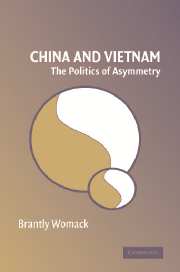Book contents
- Frontmatter
- Contents
- Tables, Figures, and Maps
- Preface
- Introduction
- 1 General Overview
- PART ONE BASIC STRUCTURE
- PART TWO THE RELATIONAL DYNAMIC
- 5 From the Beginnings to Vietnamese Independence
- 6 Unequal Empires
- 7 The Brotherhood of Oppression: 1840–1950
- 8 Lips and Teeth: 1950–1975
- 9 Illusions of Victory: 1975–1991
- 10 From Normalization to Normalcy
- 11 Change and Structure in Asymmetry
- Appendix: Glossary of Terms
- Bibliography
- Index
5 - From the Beginnings to Vietnamese Independence
Published online by Cambridge University Press: 02 December 2009
- Frontmatter
- Contents
- Tables, Figures, and Maps
- Preface
- Introduction
- 1 General Overview
- PART ONE BASIC STRUCTURE
- PART TWO THE RELATIONAL DYNAMIC
- 5 From the Beginnings to Vietnamese Independence
- 6 Unequal Empires
- 7 The Brotherhood of Oppression: 1840–1950
- 8 Lips and Teeth: 1950–1975
- 9 Illusions of Victory: 1975–1991
- 10 From Normalization to Normalcy
- 11 Change and Structure in Asymmetry
- Appendix: Glossary of Terms
- Bibliography
- Index
Summary
The history of relations between China and Vietnam is a major focus of this study. Our research concerns the interactive changes in China and Vietnam over the course of their development, and history is the record of these changes. However, the perspective taken is not that of a historian. Rather than presenting a narrative of the relationship, we shall look in the historical record for its structure. The task here is not history but the utilization of history as part of an attempt to understand comprehensively the pattern of an asymmetric relationship.
Chinese and Vietnamese authors are often concerned with the origins of their present polity – “How did we get here?” For Chinese studies, Vietnam plays a marginal role if it is noticed at all. For Vietnam, China is the foil for the development of Vietnamese nationhood. What will be stressed in this chapter is that in the beginning both polities were in a state of flux, and their interactions helped shape domestic developments and each polity's notion of itself. This is more obvious in the case of Vietnam, but Vietnam has also been an important influence on the course of China's development. For the sake of convenience, “Vietnam” and “the Vietnamese” shall be used to denote the current territory of Vietnam and its residents, and the same will be done with “China” and “the Chinese,” as well as present-day provinces such as Guangxi.
- Type
- Chapter
- Information
- China and VietnamThe Politics of Asymmetry, pp. 95 - 116Publisher: Cambridge University PressPrint publication year: 2006



